Switch Installation
Read the topics and perform the procedures in this order:
■![]() Installing and Removing SFP Modules
Installing and Removing SFP Modules
■![]() Inserting and Removing the SFP Module Patch Cable
Inserting and Removing the SFP Module Patch Cable
■![]() Replacing the SD Flash Memory Card
Replacing the SD Flash Memory Card
■![]() Connecting Devices to the Ethernet Ports
Connecting Devices to the Ethernet Ports
Warnings
These warnings are translated into several languages in the Regulatory Compliance and Safety Information for the Cisco IE 3010 Switch document that ships on the documentation CD.
These warning statements apply to all the switches:
Warning: Before working on equipment that is connected to power lines, remove jewelry (including rings, necklaces, and watches). Metal objects will heat up when connected to power and ground and can cause serious burns or weld the metal object to the terminals. Statement 43
Warning: Read the installation instructions before you connect the system to its power source. Statement 1004
Warning: This unit is intended for installation in restricted access areas. A restricted access area can be accessed only through the use of a special tool, lock and key, or other means of security. Statement 1017
Warning: This equipment must be grounded. Never defeat the ground conductor or operate the equipment in the absence of a suitably installed ground conductor. Contact the appropriate electrical inspection authority or an electrician if you are uncertain that suitable grounding is available. Statement 1024
Warning: This unit might have more than one power supply connection. All connections must be removed to de-energize the unit. Statement 1028
Warning: Only trained and qualified personnel should be allowed to install, replace, or service this equipment. Statement 1030
Warning: Ultimate disposal of this product should be handled according to all national laws and regulations. Statement 1040
Warning: For connections outside the building where the equipment is installed, the following ports must be connected through an approved network termination unit with integral circuit protection.
10/100/1000 Ethernet Statement 1044
Warning: To prevent the system from overheating, do not operate it in an area that exceeds the maximum recommended ambient temperature of:
140°F (60°C) Statement 1047
Warning: Installation of the equipment must comply with local and national electrical codes. Statement 1074
Note: For U.S. installations, refer to national electrical code ANSI/NFPA 70.
Warning: To prevent airflow restriction, allow clearance around the ventilation openings to be at least:
1.75 in. (4.4 cm). Statement 1076
Warning: Avoid using or servicing any equipment that has outdoor connections during an electrical storm. There may be a risk of electric shock from lightning. Statement 1088
Installation Guidelines
Before installing the switch, verify that these guidelines are met:
■![]() Cabling is away from sources of electrical noise, such as radios, power lines, and fluorescent lighting fixtures. Make sure that the cabling is away from other devices that might damage the cables.
Cabling is away from sources of electrical noise, such as radios, power lines, and fluorescent lighting fixtures. Make sure that the cabling is away from other devices that might damage the cables.
■![]() Operating environment is within the ranges listed in
Operating environment is within the ranges listed in
■![]() Relative humidity around the switch does not exceed 95 percent (noncondensing).
Relative humidity around the switch does not exceed 95 percent (noncondensing).
■![]() Altitude at the installation site is not higher than 10,000 feet.
Altitude at the installation site is not higher than 10,000 feet.
■![]() For 10/100 and 10/100/1000 fixed ports, cable lengths from the switch to connected devices are not more than 328 feet (100 meters).
For 10/100 and 10/100/1000 fixed ports, cable lengths from the switch to connected devices are not more than 328 feet (100 meters).
■![]() For cable lengths for small form-factor pluggable (SFP)-module connections, see the SFP Module Cables and the module documentation.
For cable lengths for small form-factor pluggable (SFP)-module connections, see the SFP Module Cables and the module documentation.
■![]() Airflow around the switch and through the vents is unrestricted. To prevent overheating, the switch must meet the minimum clearance of 1.75 inches (4.4 cm) at the top and bottom.
Airflow around the switch and through the vents is unrestricted. To prevent overheating, the switch must meet the minimum clearance of 1.75 inches (4.4 cm) at the top and bottom.
Note: If the switch is installed in a closed or multirack assembly, the temperature around it might be greater than normal room temperature.
Verifying Switch Operation
Before installing the switch in a rack or on a wall, you should power the switch and verify that the switch passes the power-on self-test (POST).
To wire the switch to the power source, see Power Supply Installation
When the switch begins POST, the SYS LED blinks green, and the other LEDs stay green. When the switch passes POST, the SYS LED turns green. The other LEDs turn off and return to their operating status. If the switch fails POST, the SYS LED is amber.
Note: Contact Cisco Systems immediately if your switch fails POST.
After a successful POST, disconnect the power from the switch. For more information, see Power Supply Installation See the Installing the Switch to install the switch in a rack or on a wall.
Installing the Switch
If the switch is wall-mounted in an enclosure, follow these minimum clearances:
■![]() Sides of switch (facing up and facing down): 3.75 in. (9.52 cm)
Sides of switch (facing up and facing down): 3.75 in. (9.52 cm)
■![]() Power supply side: 5.25 in. (13.33 cm)
Power supply side: 5.25 in. (13.33 cm)
■![]() Cover side (side not facing wall): 1.75 in. (4.44 cm)
Cover side (side not facing wall): 1.75 in. (4.44 cm)
■![]() Base side (facing wall): 0 in. (0 cm)
Base side (facing wall): 0 in. (0 cm)
Rack-Mounting
To rack-mount the switch, select the rack size and follow the steps in these sections:
■![]() Attaching Brackets for 19-Inch Racks
Attaching Brackets for 19-Inch Racks
■![]() Attaching Brackets for 19-Inch Racks for IP-30 Compliance (Optional)
Attaching Brackets for 19-Inch Racks for IP-30 Compliance (Optional)
■![]() Attaching Brackets for 23-Inch Racks
Attaching Brackets for 23-Inch Racks
■![]() Attaching Brackets for ETSI Racks
Attaching Brackets for ETSI Racks
Warning: For mounting railway-application equipment and for EN50155 standard compliance, the switch must be installed only in a rack mid-mounting position. If you install the switch in a front rack-mounting (cable side or power supply side) position or in a wall-mounting position, a mechanical failure can occur that results in the switch becoming detached from the rack. Statement 403
Attaching Brackets for 19-Inch Racks
Figure 10 and Figure 11 show how to attach brackets to the switches.
Figure 10 Attaching Brackets for 19-Inch Racks
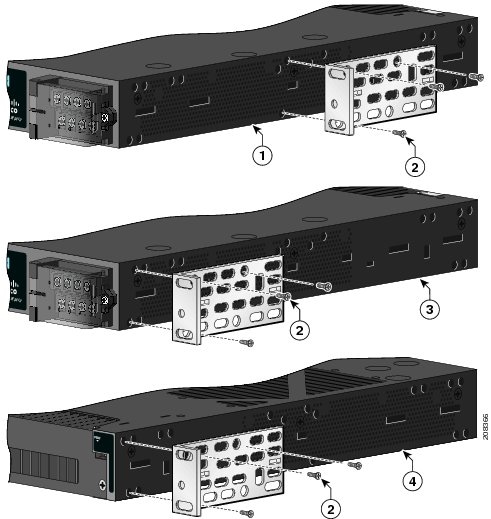
|
|
|
||
|
|
|
Figure 11 Attaching Brackets for 19-Inch Racks
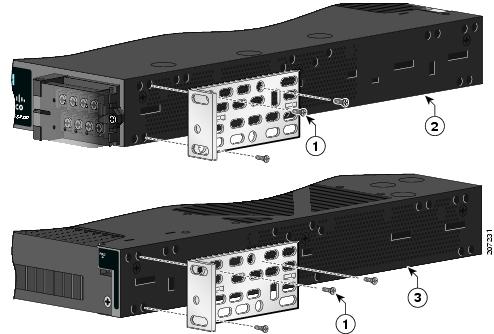
|
|
|
||
|
|
|
Attaching Brackets for 19-Inch Racks for IP-30 Compliance (Optional)
Before installing the mounting brackets, you need to install the rubber plugs in the unused mounting holes. The rubber plugs are not supplied with the switch. You can order a kit (part number IE-3010-IP30KIT) containing the rubber plugs.
You can order a kit (part number IE-3010-IP30KIT) that contains the rubber plugs.
Figure 12 shows a close-up of the rubber plug. You can install the rubber plugs in the holes as shown in Figure 13 and Figure 14.
Figure 12 Inserting the Rubber Plug

|
|
|
||
|
|
|
1.![]() Identify your bracket mounting position. See Figure 15 or Figure 16.
Identify your bracket mounting position. See Figure 15 or Figure 16.
2.![]() Insert the rubber plugs in the appropriate holes on both sides of the switch. See Figure 13 or Figure 14.
Insert the rubber plugs in the appropriate holes on both sides of the switch. See Figure 13 or Figure 14.
3.![]() Use a screwdriver or pen to completely push in the rubber plugs. See Figure 12.
Use a screwdriver or pen to completely push in the rubber plugs. See Figure 12.
4.![]() Install the brackets on both sides of the switch. See Figure 15 or Figure 16.
Install the brackets on both sides of the switch. See Figure 15 or Figure 16.
Figure 13 Inserting the Rubber Plugs

|
|
|
||
|
|
|
Figure 14 Inserting the Rubber Plugs

|
|
|
||
|
|
|
Figure 15 Attaching Brackets for 19-Inch Racks

|
|
|
||
|
|
|
Figure 16 Attaching Brackets for 19-Inch Racks
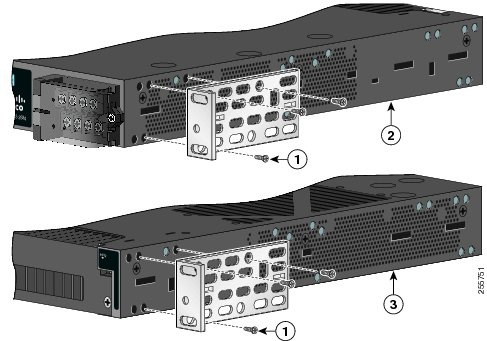
|
|
|
||
|
|
|
Note: For IP-30 compliance: If you use 23-inch brackets or ETSI brackets, you can insert the rubber plugs in the same holes as shown in Figure 13 or Figure 14 before installing the brackets.
Attaching Brackets for 23-Inch Racks
Figure 17 Attaching 23-Inch Brackets

|
|
|
||
|
|
|
Note: For IP-30 compliance: If you use 23-inch brackets, you can insert the rubber plugs in the same holes as shown in Figure 13 or Figure 14 before installing the brackets.
Attaching Brackets for ETSI Racks
Figure 18 Attaching Brackets for ETSI Racks

|
|
|
||
|
|
|
Note: For IP-30 compliance: If you use ETSI brackets, you can insert the rubber plugs in the same holes as shown in Figure 13 or Figure 14 before installing the brackets.
Rack-Mounting the Switch
After you attach the brackets on the switch, use the four supplied number-12 Phillips machine screws to attach the brackets to the rack. See Figure 19.
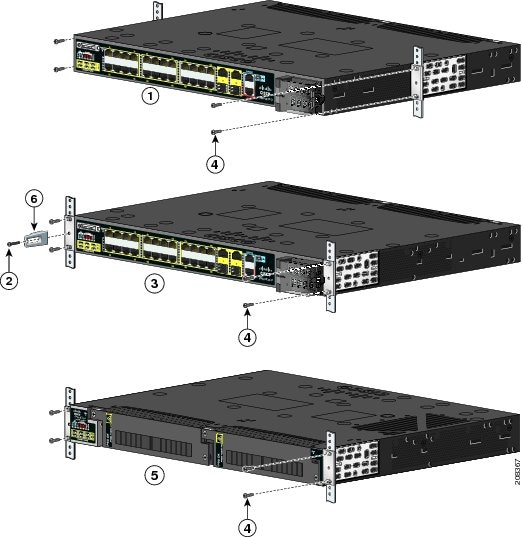
|
|
|
||
|
|
|
||
|
|
|
After the switch is mounted in the rack:
1.![]() Wire the switch to a power source. See Power Supply Installation
Wire the switch to a power source. See Power Supply Installation
2.![]() Connect the ports. See the Connecting Devices to the Ethernet Ports.
Connect the ports. See the Connecting Devices to the Ethernet Ports.
3.![]() Attach the cable guide to prevent the cables from obscuring the LED panels on the devices in the rack. Use the supplied black screw shown in Figure 19 to attach the cable guide to the left or right bracket.
Attach the cable guide to prevent the cables from obscuring the LED panels on the devices in the rack. Use the supplied black screw shown in Figure 19 to attach the cable guide to the left or right bracket.
For configuration instructions about the CLI setup program, go to Configuring the Switch with the CLI Setup Program
Wall-Mounting
To wall-mount the switch, follow the steps in these sections:
■![]() Attaching Brackets for IP-30 Compliance (Optional)
Attaching Brackets for IP-30 Compliance (Optional)
Warning: Read the wall-mounting instructions carefully before beginning installation. Failure to use the correct hardware or to follow the correct procedures could result in a hazardous situation to people and damage to the system. Statement 378
Warning: For mounting railway-application equipment and for EN50155 standard compliance, the switch must be installed only in a rack mid-mounting position. If you install the switch in a front rack-mounting (cable side or power supply side) position or in a wall-mounting position, a mechanical failure can occur that results in the switch becoming detached from the rack. Statement 403
If the switch is wall-mounted in an enclosure, follow these minimum clearances:
■![]() Sides of switch (facing up and facing down): 3.75 in. (9.52 cm)
Sides of switch (facing up and facing down): 3.75 in. (9.52 cm)
■![]() Power supply side: 5.25 in. (13.33 cm)
Power supply side: 5.25 in. (13.33 cm)
Attaching Brackets
Figure 20 Attaching 19-inch Rack Brackets
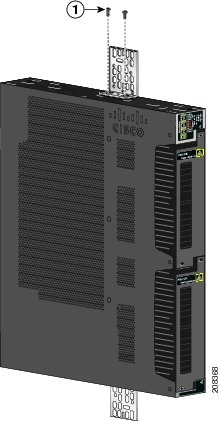
|
|
Attaching Brackets for IP-30 Compliance (Optional)
1.![]() Insert the rubber plugs in the appropriate holes on both sides of the switch. See Figure 21.
Insert the rubber plugs in the appropriate holes on both sides of the switch. See Figure 21.
Note: The rubber plugs are not supplied with the switch. You can order a kit (part number IE-3010-IP30KIT) containing the rubber plugs.
2.![]() Use a screwdriver or pen to completely push in the rubber plugs. See Figure 12.
Use a screwdriver or pen to completely push in the rubber plugs. See Figure 12.
3.![]() Install the brackets on both sides of the switch. See Figure 22.
Install the brackets on both sides of the switch. See Figure 22.
Figure 21 Inserting the Rubber Plugs in the Switch Holes
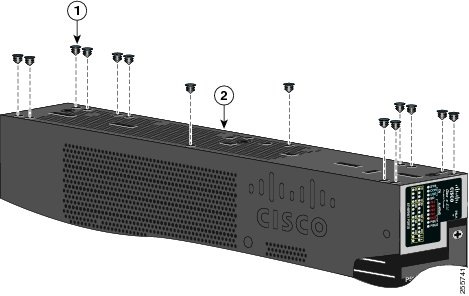
|
|
|
|
|
Figure 22 Attaching 19-inch Rack Brackets
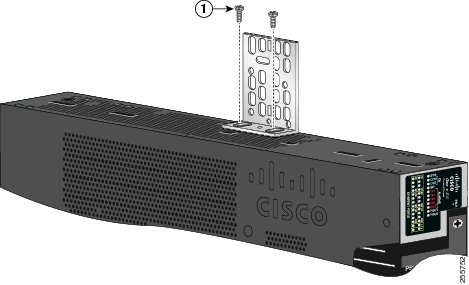
|
|
Wall-Mounting the Switch
For the best support of the switch and cables, ensure that the switch is attached securely to wall studs or to a firmly attached plywood mounting backboard.
Mount the switch with the side panel facing up. Ensure that the Cisco logo is at the top of the switch. See Figure 23 and Figure 24.
Figure 23 Wall-Mounting the Cisco IE-3010-24TC
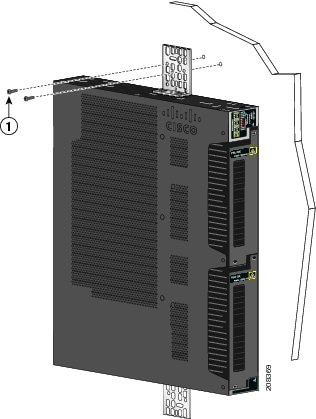
|
|
Figure 24 Wall-Mounting the Cisco IE-3010-16S-8PC

After the switch is mounted on the wall:
■![]() Wire the switch to a power source. See Power Supply Installation
Wire the switch to a power source. See Power Supply Installation
■![]() For configuration instructions about using the CLI setup program, go to Configuring the Switch with the CLI Setup Program
For configuration instructions about using the CLI setup program, go to Configuring the Switch with the CLI Setup Program
■![]() Connect the switch ports. See the Connecting Devices to the Ethernet Ports.
Connect the switch ports. See the Connecting Devices to the Ethernet Ports.
Installing and Removing SFP Modules
This section presents procedures to install and remove fiber-optic and 1000BASE-T SFP transceiver modules.
Installing SFP Modules
These sections describe how to install and remove SFP modules. SFP modules are inserted into SFP module slots on the front of the switch. Field-replaceable SFP modules provide the uplink interfaces, send (TX) and receive (RX).
You can use any combination of rugged SFP modules. See Table 2 for a list of supported modules. Each SFP module must be of the same type as the SFP module on the other end of the cable, and the cable must not exceed the stipulated cable length for reliable communications. See Table 20 for cable stipulations for SFP module connections.
Caution: When you use commercial SFP modules such as CWDM and 1000BX-U/D, reduce the maximum operating temperature by 59°F (15°C). The minimum operating temperature is 32°F (0°C).
Caution: To prevent electrostatic-discharge (ESD) damage, follow standard board and component handling procedures.
Warning: Do not insert and remove SFP modules while power is on; an electrical arc can occur. This could cause an explosion in hazardous location installations. Be sure that power is removed or the area is nonhazardous before proceeding. Statement 1087
Note: Removing and installing an SFP module can shorten its useful life. Do not remove and insert any module more often than is absolutely necessary.
Figure 28 shows an LC SFP module with a bale-clasp latch.
Caution: Do not install or remove the LC SFP module with fiber-optic cables attached because of potential damage to the cables, the cable connector, or the optical interfaces in the SFP module. Disconnect all cables before removing or installing an SFP module. Removing and installing an SFP module can shorten its useful life. Do not remove and insert SFP modules more often than is absolutely necessary.
Installing Fiber Optic SFP Modules
Warning: Class 1 laser product. Statement 1008
To install and cable an optical SFP transceiver uplink port:
1.![]() Attach an ESD-preventive wrist strap to your wrist and to a bare metal surface.
Attach an ESD-preventive wrist strap to your wrist and to a bare metal surface.
2.![]() Find the send (TX) and receive (RX) markings on the module top.
Find the send (TX) and receive (RX) markings on the module top.
On some SFP modules, the send and receive (TX and RX) markings might be replaced by arrows that show the direction of the connection, either send or receive (TX or RX).
3.![]() If the module has a bale-clasp latch, move it to the open, unlocked position.
If the module has a bale-clasp latch, move it to the open, unlocked position.
4.![]() Align the module in front of the slot opening, and push until you feel the connector snap into place.
Align the module in front of the slot opening, and push until you feel the connector snap into place.
5.![]() If the module has a bale-clasp latch, close it.
If the module has a bale-clasp latch, close it.
6.![]() For fiber-optic SFP modules, remove the dust plugs and save.
For fiber-optic SFP modules, remove the dust plugs and save.
Figure 25 Installing an SFP Module
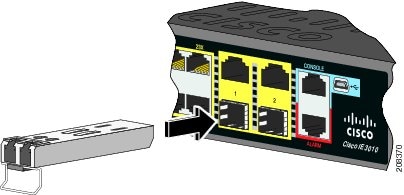
Caution: Do not remove the dust plugs from the fiber-optic SFP module port or the rubber caps from the fiber-optic cable until you are ready to connect the cable. The plugs and caps protect the SFP module ports and cables from contamination and ambient light.
Installing 1000BASE-T SFP Modules
The 1000BASE-T (copper) SFP transceiver, see Figure 26, has a bale-clasp locking mechanism that secures the transceiver in the module socket. The SFP network interface is an RJ-45 connector.
Figure 26 1000BASE-T SFP Transceiver
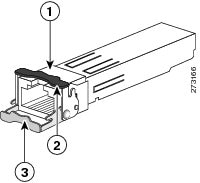
| Bale-clasp latching mechanism in the open (unlocked) position. |
|||
| Bale-clasp latching mechanism in the closed (locked) position. |
Caution: To comply with GR-1089 intrabuilding lightning immunity requirements, you must use grounded, shielded, twisted-pair, CAT5 cabling.
Note: When connecting to a 1000BASE-T-compatible server, workstation, or router, use four twisted-pair, straight-through CAT5 cabling for the SFP transceiver port. When connecting to a 1000BASE-T-compatible switch or repeater, use four twisted-pair, crossover CAT5 cabling.
To install a 1000BASE-T SFP transceiver:
1.![]() Attach an ESD-preventive wrist strap to your wrist and to the ESD ground connector on the chassis or to a properly grounded bare metal surface.
Attach an ESD-preventive wrist strap to your wrist and to the ESD ground connector on the chassis or to a properly grounded bare metal surface.
Caution: To avoid ESD damage, handle the SFP by its sides; do not touch the connector pins.
2.![]() Remove the new 1000BASE-T SFP module from its protective packaging.
Remove the new 1000BASE-T SFP module from its protective packaging.
3.![]() Check the markings on the SFP transceiver to verify that you have the correct model for your network.
Check the markings on the SFP transceiver to verify that you have the correct model for your network.
4.![]() Position the SFP transceiver in front of the port socket opening.
Position the SFP transceiver in front of the port socket opening.
Note: Different Cisco devices have different SFP transceiver socket configurations. Your Cisco device might require that the SFP transceiver be installed with the bale-clasp either in a latch-up or a latch-down orientation. Verify that you have the SFP transceiver oriented correctly when you position it in front of the port socket.
5.![]() With the bale-clasp closed (locked), slide the SFP transceiver into the socket until you feel it snap in place in the socket. You may hear an audible click as the SFP transceiver latch engages in the socket (Figure 25).
With the bale-clasp closed (locked), slide the SFP transceiver into the socket until you feel it snap in place in the socket. You may hear an audible click as the SFP transceiver latch engages in the socket (Figure 25).
6.![]() Connect the network interface cable RJ-45 plug to the SFP RJ-45 connector.
Connect the network interface cable RJ-45 plug to the SFP RJ-45 connector.
7.![]() Observe the port status LED:
Observe the port status LED:
–![]() Green indicates that the SFP transceiver and the target device established a link.
Green indicates that the SFP transceiver and the target device established a link.
–![]() Amber indicates that the port is discovering the network topology and searching for loops. This process takes about 30 seconds, and then the LED turns green.
Amber indicates that the port is discovering the network topology and searching for loops. This process takes about 30 seconds, and then the LED turns green.
–![]() Off indicates that the target device might not be turned on, there might be a cable problem, or there might be a problem with the adapter installed in the target device. Refer to Troubleshooting for solutions to cabling problems.
Off indicates that the target device might not be turned on, there might be a cable problem, or there might be a problem with the adapter installed in the target device. Refer to Troubleshooting for solutions to cabling problems.
Connecting to SFP Modules
This section describes how to connect to a fiber-optic or 1000BASE-T SFP port. To connect to an RJ-45 Gigabit Ethernet port, see Connecting to a Dual-Purpose Port. For instructions on how to install or remove an SFP module, see Connecting Devices to the Ethernet Ports.
Warning: Class 1 laser product. Statement 1008
Warning: Do not connect or disconnect cables to the ports while power is applied to the switch or any device on the network because an electrical arc can occur. This could cause an explosion in hazardous location installations. Be sure that power is removed from the switch and cannot be accidentally be turned on, or verify that the area is nonhazardous before proceeding. Statement 1070
Caution: Do not remove the rubber plugs from the SFP module port or the rubber caps from the fiber-optic cable until you are ready to connect the cable. The plugs and caps protect the SFP module ports and cables from contamination and ambient light.
Before connecting to the SFP module, ensure that you understand the port and cabling guidelines in the SFP Module Connectors. See Connector and Cable Specifications for information about the LC on the SFP module.
Caution: To prevent ESD damage, follow standard board and component handling procedures.
Connecting to a Fiber Optic SFP Module
To connect a fiber-optic cable to an SFP module:
1.![]() Remove the rubber plugs from the module port and fiber-optic cable, and store them for future use.
Remove the rubber plugs from the module port and fiber-optic cable, and store them for future use.
2.![]() Insert one end of the fiber-optic cable into the SFP module port. See Figure 27.
Insert one end of the fiber-optic cable into the SFP module port. See Figure 27.
Figure 27 Connecting to a Fiber-Optic SFP Module Port
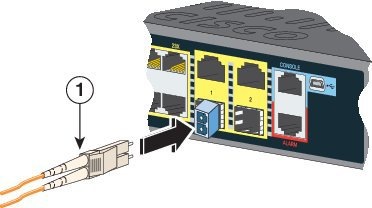
|
|
3.![]() Insert the other cable end into a fiber-optic receptacle on a target device.
Insert the other cable end into a fiber-optic receptacle on a target device.
4.![]() Observe the port status LED:
Observe the port status LED:
–![]() The LED turns green when the switch and the target device have an established link.
The LED turns green when the switch and the target device have an established link.
–![]() The LED turns amber while the STP discovers the network topology and searches for loops. This process takes about 30 seconds, and then the port LED turns green.
The LED turns amber while the STP discovers the network topology and searches for loops. This process takes about 30 seconds, and then the port LED turns green.
–![]() If the LED is off, the target device might not be turned on, there might be a cable problem, or there might be a problem with the adapter installed in the target device. See Troubleshooting for solutions to cabling problems.
If the LED is off, the target device might not be turned on, there might be a cable problem, or there might be a problem with the adapter installed in the target device. See Troubleshooting for solutions to cabling problems.
5.![]() If necessary, reconfigure and restart the switch or the target device.
If necessary, reconfigure and restart the switch or the target device.
Connecting to a 1000BASE-T SFP Module
To connect a CAT5 cable to a 1000BASE-T SFP module:
Caution: To prevent ESD damage, follow standard board and component handling procedures.
1.![]() When connecting to servers, workstations, and routers, insert a four twisted-pair, straight-through cable in the RJ-45 connector. When connecting to switches or repeaters, insert a four twisted-pair, crossover cable.
When connecting to servers, workstations, and routers, insert a four twisted-pair, straight-through cable in the RJ-45 connector. When connecting to switches or repeaters, insert a four twisted-pair, crossover cable.
Note: When connecting to a 1000BASE-T device, use a four twisted-pair CAT5 cable.
2.![]() Insert the other cable end in an RJ-45 connector on a target device.
Insert the other cable end in an RJ-45 connector on a target device.
3.![]() Observe the port status LED.
Observe the port status LED.
–![]() The LED turns green when the switch and the target device have an established link.
The LED turns green when the switch and the target device have an established link.
–![]() The LED turns amber while the STP discovers the network topology and searches for loops. This process takes about 30 seconds, and then the port LED turns green.
The LED turns amber while the STP discovers the network topology and searches for loops. This process takes about 30 seconds, and then the port LED turns green.
–![]() If the LED is off, the target device might not be turned on, there might be a cable problem, or there might be problem with the adapter installed in the target device. See Troubleshooting for solutions to cabling problems.
If the LED is off, the target device might not be turned on, there might be a cable problem, or there might be problem with the adapter installed in the target device. See Troubleshooting for solutions to cabling problems.
4.![]() If necessary, reconfigure and restart the switch or target device.
If necessary, reconfigure and restart the switch or target device.
Removing SFP Modules
1.![]() Attach an ESD-preventive wrist strap to your wrist and to a bare metal surface.
Attach an ESD-preventive wrist strap to your wrist and to a bare metal surface.
2.![]() Disconnect the cable from the SFP module. For reattachment, note which cable connector plug is send (TX) and which is receive (RX).
Disconnect the cable from the SFP module. For reattachment, note which cable connector plug is send (TX) and which is receive (RX).
3.![]() Insert a dust plug into the optical ports of the SFP module.
Insert a dust plug into the optical ports of the SFP module.
4.![]() If the module has a bale-clasp latch, pull the bale out and down to eject it. If the latch is obstructed and you cannot use your finger, use a small, flat-blade screwdriver or other long, narrow instrument.
If the module has a bale-clasp latch, pull the bale out and down to eject it. If the latch is obstructed and you cannot use your finger, use a small, flat-blade screwdriver or other long, narrow instrument.
5.![]() Grasp the SFP module, and carefully remove it from the slot.
Grasp the SFP module, and carefully remove it from the slot.
6.![]() Place the module in an antistatic bag or other protective environment.
Place the module in an antistatic bag or other protective environment.
Figure 28 Removing a Bale-Clasp Latch SFP Module
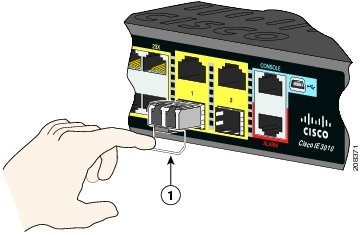
|
|
Inserting and Removing the SFP Module Patch Cable
1.![]() Attach an ESD-preventive wrist strap to your wrist and to a bare metal surface.
Attach an ESD-preventive wrist strap to your wrist and to a bare metal surface.
2.![]() Insert the SFP module patch cable in the slot until you feel the connector on the cable snap into place at the rear of the slot (see Figure 29).
Insert the SFP module patch cable in the slot until you feel the connector on the cable snap into place at the rear of the slot (see Figure 29).
Figure 29 Inserting an SFP Module Patch Cable
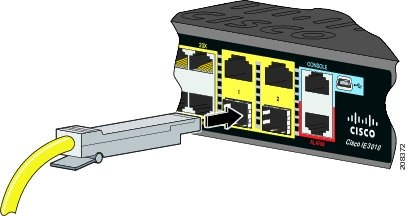
3.![]() Repeat these steps for the second switch that you want to connect to the first switch.
Repeat these steps for the second switch that you want to connect to the first switch.
Figure 30 Connecting Two Switches with an SFP Module Patch Cable
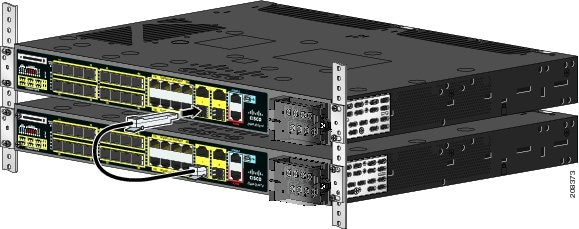
Removing the SFP Module Patch Cable
To remove an SFP module patch cable from the SFP module slot, release the connector, and pull it from the slot.
Replacing the SD Flash Memory Card
1.![]() Locate the SD flash memory card slot on the cable-side of the switch.
Locate the SD flash memory card slot on the cable-side of the switch.
2.![]() Use a number-1 Phillips screwdriver to loosen the captive screw. See Figure 31.
Use a number-1 Phillips screwdriver to loosen the captive screw. See Figure 31.
Figure 31 Loosening the Captive Screw
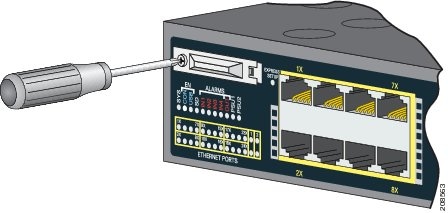
3.![]() Pull the cover open, and pull the cover tab from the hinge. See Figure 32.
Pull the cover open, and pull the cover tab from the hinge. See Figure 32.
Figure 32 Removing the SD Slot Cover
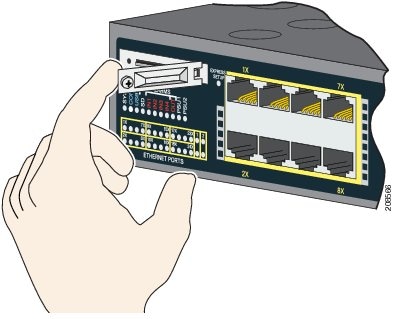
4.![]() Gently push the SD flash memory card to eject it. See Figure 33. Place it in an antistatic bag to protect it from static discharge.
Gently push the SD flash memory card to eject it. See Figure 33. Place it in an antistatic bag to protect it from static discharge.
Figure 33 Removing the SD Flash Memory Card.
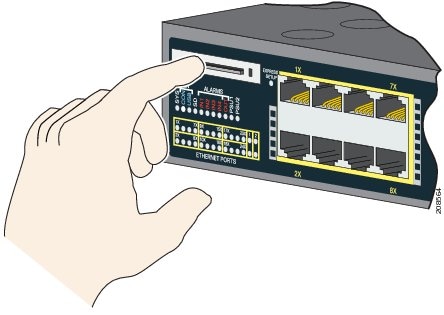
5.![]() Push the replacement card (upside down) into the slot, and press it firmly in place. The card is keyed so that you cannot insert it the wrong way.
Push the replacement card (upside down) into the slot, and press it firmly in place. The card is keyed so that you cannot insert it the wrong way.
6.![]() Place the SD slot cover tabs into the hinge.
Place the SD slot cover tabs into the hinge.
7.![]() Close the cover, and use a ratcheting torque number-1 Phillips screwdriver to torque the screw to
Close the cover, and use a ratcheting torque number-1 Phillips screwdriver to torque the screw to
4.5 in-lb.
Connecting to a Dual-Purpose Port
The dual-purpose port is a single port with two interfaces, one for an RJ-45 cable and another for an SFP module. Only one interface can be active at a time. If both interfaces are connected, the SFP module has priority. For more information about dual-purpose ports, see the Dual-Purpose Ports.
Warning: Class 1 laser product. Statement 1008
Caution: Do not remove the rubber plugs from the SFP module port or the rubber caps from the fiber-optic cable until you are ready to connect the cable. The plugs and caps protect the SFP module ports and cables from contamination and ambient light. Before connecting to the SFP module, ensure that you understand the port and cabling stipulations in the Installation Guidelines. See Connector and Cable Specifications for information about the LC on the SFP module.
To connect to a dual-purpose port, follow these steps:
1.![]() Connect an RJ-45 connector to the 10/100/1000 port, or install an SFP module into the SFP module slot, and connect a cable to the SFP module port. See Figure 34.
Connect an RJ-45 connector to the 10/100/1000 port, or install an SFP module into the SFP module slot, and connect a cable to the SFP module port. See Figure 34.
For more information about RJ-45 connections, SFP modules, and optical connections, see the Connecting Devices to the Ethernet Ports, the Connecting Devices to the Ethernet Ports, and the Connecting to SFP Modules.
Figure 34 Connecting to a Dual-Purpose Port
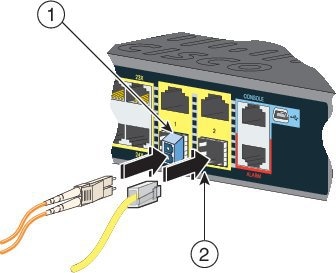
|
|
|
2.![]() Connect the other end of the cable to the other device.
Connect the other end of the cable to the other device.
By default, the switch detects whether an RJ-45 connector or SFP module is connected to a dual-purpose port and configures the port accordingly. You can change this setting and configure the port to recognize only an RJ-45 connector or only an SFP module by using the media typ e interface configuration command. For more information, see the Cisco IE 3010 Switch Command Reference.
Connecting Devices to the Ethernet Ports
■![]() Connecting to the 10/100 and 10/100/1000 Ports
Connecting to the 10/100 and 10/100/1000 Ports
■![]() Connecting to the 10/100 PoE Ports
Connecting to the 10/100 PoE Ports
Connecting to the 10/100 and 10/100/1000 Ports
The 10/100 and 10/100/1000 Ethernet ports use standard RJ-45 connectors with Ethernet pinouts. The maximum cable length is 328 feet (100 meters). The 100BASE-TX and 1000BASE-T traffic requires CAT5, CAT5e, or CAT6 UTP cable. The 10BASE-T traffic uses Category 3 or Category 4 cable.
The autonegotiation feature is enabled by default on the switch. At this setting, the switch ports configure themselves to operate at the speed of the attached device. If the device does not support autonegotiation, you can set the switch port speed and duplex parameters. To maximize performance, either let the ports autonegotiate both speed and duplex, or set the port speed and duplex parameters on both ends of the connection.
For simplified cabling, the automatic medium-dependent interface crossover (auto-MDIX) feature is enabled by default. With auto-MDIX enabled, the switch detects the required cable type for copper Ethernet connections and configures the interface accordingly. Therefore, you can use either a crossover or a straight-through cable for connections to a 10/100/1000 Ethernet port, regardless of the type of connected device.
See the switch software configuration guide or the switch command reference on Cisco.com for more information about autonegotiation and auto-MDIX.
If auto-MDIX is disabled, use the guidelines in Table 11 to select the cable for connecting the 10/100/1000 Ethernet ports to other devices. See the Connector and Cable Specifications appendix for cable-pinout descriptions. See Figure 35.
Figure 35 Connecting to an Ethernet Port

|
|
|
|
|---|---|---|
|
1.100BASE-TX and 1000BASE-T traffic requires twisted four-pair, CAT5, CAT5e, or CAT6 cable. 10BASE-T traffic uses Category 3 or Category 4 cable. |
Connecting to the 10/100 PoE Ports
The Cisco IE-3010-16S-8PC switch 10/100 PoE ports have the same autonegotiation settings and cabling requirements as those in the Connecting to the 10/100 and 10/100/1000 Ports. These ports provide PoE power.
See the PoE Ports for information on the cables and connectors.
The ports provide PoE support for devices compliant with IEEE 802.3af and also provide Cisco prestandard PoE support for Cisco IP Phones and Cisco Aironet Access Points.
On a per-port basis, you can control whether or not a port automatically provides power to a connected IP phone or an access point.
To access an advanced PoE planning tool, use the Cisco Power Calculator on Cisco.com:
http://tools.cisco.com/cpc/launch.jsp
You can use this application to calculate the power supply requirements for a specific PoE configuration. The results show output current, output power, and heat dissipation.
Warning: Voltages that present a shock hazard may exist on Power over Ethernet (PoE) circuits if interconnections are made using uninsulated exposed metal contacts, conductors, or terminals. Avoid using such interconnection methods, unless the exposed metal parts are located within a restricted access location and users and service people who are authorized within the restricted access location are made aware of the hazard. A restricted access area can be accessed only through the use of a special tool, lock and key or other means of security. Statement 1072
Caution: Category 5e and Category 6 cables can store high levels of static electricity. Always ground the cables to a suitable and safe earth ground before connecting them to the switch or other devices.
Where to Go Next
You can use the default configuration or use any of the management options described in the Management Options to change the switch settings.
 Feedback
Feedback